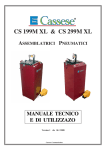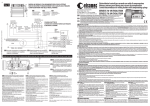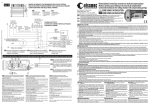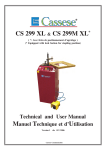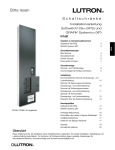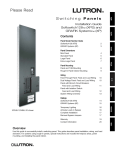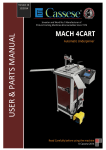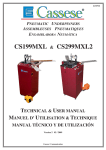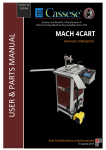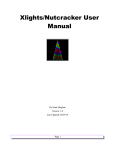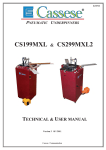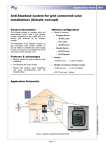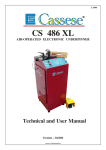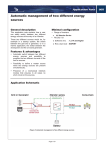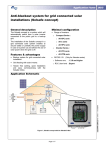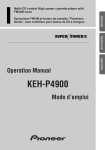Download CS 85 & CS85JR
Transcript
Z 5169 DE BRUIT -E AU L E 74 Db EL DEL NIV R DO UI NO IS CS 85 VEL - NIV LE E PNEUMATIC UNDERPINNERS ASSEMBLEUSES PNEUMATIQUES CS 85 JR Technical and User Manual Manuel Technique & d’Utilisation Version 1 - 10 / 2000 Sté CASSESE , Zone Industrielle - Verneuil l’Etang - 77390 - FRANCE Tel : + 33.1.64-42-49-71 / Fax : +33.1.64-42-58-94 Web: www.cassese.com / e-Mail: [email protected] Cassese / Communication $ ! " '& ( + %& $ - $ ; , . 0 12 %67 8 , & ; 0 6 - - "" ) $ 3$ 96 & 2 2 & & " + 1 $<-5 $ 3 3 < " & = "& " "& " C $ +& +& 0 C C 2 & 2 & " # ! " '& "/ -;$ + " # - ; --; - $ ; $ ; - " "& " 3 & 0 68? .< &" "& " + " 15 % + " ,# / " & 96 8 $<-5 < 1 = , 5 ? "2 $ & 4 2 "& #!" B6 & :) + "" ! & 4 & 4 & 4 & 4 "& #!" " & # B6 & && > , C " %67 / " # & 4 12 5$ && & & & & #!" & /" & & 4 2 ? "2. 3$ 3 < 3 3 3 " - > & 0 2 0 2 0 2 0 2 .& " "& &" + " , :) # * & # 5 " " & @ 3 A < A 5 2 2 2 2 5$ 5 5 5 " @ 3 A &" " & & 5 &@ & # & & &" & 15 " + * " # ,!& & D < A $ $ $ $ + " / .& " % ! + " 0 ,1 & 2 & 2 & & $ $ ;;; & + / "& E " 6 #!" " ) /" " " & 4 ,1 5 ? "2 ? "2 4@ 3 A ? "2 $ ? "2 $ ! & 4 "! 4@ 3 A ? " 4" ! " 4@ 3 A F ! & E 3 5 $ 5 5$ + "" 5 + *" & & "& 3 2 $ 2 $ &(" " ; ; $ & ? " " &/ ! & & & 6 ; $ & - ; -$ --; ; $$ ; $ $ $ ; -; $ $ ---$ % % % + " ,& # + ! 0 2 0 2 0 2 0 2 E 2 + " &# & ! ,# ! 5 "& + + " , & + " & &" 0 " + " , 1 0 12 0 12 " & & " 3 5 $ 5$ 5$ 3 & 33 3 3 3 $ 3$ &" &" & 4 2 & 4 2 & 4 2 & 4 2 & 4 2 + "" 5 2 & & 5! " "# ! 5 # # " & / & && " 5 )# / & 1 3 3$ &" &" & &" "& # #& / # H % 1 @ $< & & # # " H , $ ; "E C #& / # & # 55 5 5 5 $ &" 2 5 # 5 " &" G " " # & + , 5 " 2 & " & 4 + "" " , " &1 1 & 4 12 5 & 4 12 5$ F # ! & 2 & &" H ! & 4 # ! & & # ,& # &" H & 4 F # "& " & 4 "! & # 4& H F # &" " " Fig N°1 BP Po E BP B2 Pr P3 H B1 P1 P2 B Fig N°3 F AS St CS 85 PNEUMATIC FRAME ASSEMBLING MACHINE ANGLE ADJUSTMENT SCREW LIMIT STOP 1st BACKFENCE 2nd BACKFENCE ROTATING BASE CABINET 90° JOINING ANGLE ASSEMBLY WIRE FOR WEDGE PUSHING SPRING WEDGE DISTRIBUTOR LEVER FOR STAPLING POSITION (inside of frame) LEVER FOR STAPLING POSITION (outside of frame) LEVER FOR ONLY ONE OR INTERMEDIATE POSITIONS FOOT PEDAL TOP PRESSER BRACKET TOP PRESSER BASE CABINET LOCKERS EXTENSION TABLE FRONT Ta Ta F St F St P St P Fig N°2 WORK POSITION REFERENCE 1 AS B B1 B2 BP E F H P1 P2 P3 P Po Pr St Ta CS 85 - USER’S TECHNICAL MANUAL CONTENTS Page 2 INTRODUCTION ACCESSORIES SUPPLIED WITH THE MACHINE TECHNICAL SPECIFICATIONS OPTIONS GUARANTEE PUTTING INTO OPERATION REASSEMBLY & PUTTING INTO OPERATION 3 (cs85) 3A (cs85Jr) ADJUSTMENTS 4 4-5 6 6 SELECTION OF STAPLING POSITIONS SETTING AND STORING THE STAPLING POSITIONS SELECTION OF TOP PRESSER ADJUSTMENT OF THE ASSEMBLY ANGLE USE 7 MEANS OF ASSEMBLY LOADING THE WEDGE CARTRIDGE ON MACHINE JOINING THE FRAME MAINTENANCE LUBRICATION CLEARING A WEDGE STUCK IN THE WEDGE DISTRIBUTOR IN CASE OF HAMMER & WEDGE JAMMING CS 85 & CS 85Jr 10 / 2000 8 8 9 INTRODUCTION You have just bought a CS 85 OR CS85Jr frame joining machine, so we congratulate on your sensible choice and thank you for your trust in Cassese products. The CS 85 benefits from the experience of the joining machines that brought Cassese a certain reputation. It makes it possible to join wooden mouldings of all profiles ( patent n° 7522814). The CS 85 is designed to allow the operator to move all around the machine.The joining operation is carried out by using metal wedges especially designed to perform a tight join. These wedges come in throw-away plastic cartridges, without glue, individually lubricated and rust- protected for the toughest challenges. IMPORTANT: You should not use other wedge cartridges than those manufactured by Cassese and marketed by official Cassese distributors (registered mark CS). BEWARE OF COPIES. ACCESSORIES SUPPLIED WITH THE MACHINE 1 support for triangle top presser with 1 black rubber triangle (for hardwoods) + 1 white triangle (softwoods) / 1 spare hammer (wedge driver blade) / 4 Allen keys for hexagonal nuts (2.5-3-4-5 mm)/1 wedge pusher tool /1 quick release female connection /CS85:1 extension table - CS85Jr: 2 attachment arms + 4 screws / 1 insert with support (fixed on machine). TECHNICAL SPECIFICATIONS OF CS 85 & CS 85 Jr Minimum moulding width : 3mm (1/8”) Minimum moulding height : 7 mm (¼”) Furthest stapling position from back of moulding (at 45°) : 74 mm (3”) / Wedge sizes in cartridges of 275 pieces : 5, 7, 10, 12 and 15 mm.Two wedge types : for soft and for hardwoods / Energy needed : compressed air 6-7 bars ( +/- 100 p.s.i. ) / Machine gross weight :CS 85 = 40 kg (85 lbs) / CS 85Jr = 20 kg ( 42.5 lbs) Dimensions : CS 85 : 507mm(20”)x 507mm (20”)(w/out ext. table)x1100 mm high (44”) CS 85Jr : 300mm (12 ” ) x 490 mm (191/2 ”) x 535 mm high (211/2 ”) Cassese Item # Z 4511 Z 4512 OPTIONAL ACCESSORIES AVAILABLE Description 120° Joining angle assembly (for 6-sided frames) 135° Joining angle assembly (for 8-sided frames) Other top pressers : Cassese Item # Description Z 4556 White Triangle with support Z 887 Black Triangle with support Z 4558 Short orange rubber with support Z 4559 Short green rubber with support Z 4560 Long orange rubber with support Z 4561 Long green rubber with support Z 1800 Long orange rubber w/out support Z 1804 Long green rubber w/out support Z 1783 Short orange rubber w/out support Z 1791 Short green rubber w/out support For use on Soft wood Hardwoods Softwoods Hardwoods Softwoods Hardwoods Softwoods Hardwoods Softwoods Hardwoods Maxi moulding height 48 mm (2 ”) 48 mm (2 ”) 48 mm (2”) 48 mm (2 ”) 33 mm (1 1/4”) 33 mm (1 1/4”) 63 mm (2 1/2”) 63 mm (2 1/2”) 78 mm (3 1/8”) 78 mm (3 1/8”) GUARANTEE One year guarantee for parts and labour against manufacturing defects. Wear parts and those damaged as a result of non appliance with the instructions of the present manual are excluded from the guarantee. 2 INTRODUCTION Vous venez d’acquérir une CS 85. Nous vous félicitons pour votre bon choix et vous remercions pour votre confiance. La CS 85 bénéficie de l’expérience des assembleuses qui ont fait la notoriété de Cassese. La CS 85 permet l’assemblage des moulures en bois de tous profils (Brevet n’ 7522814) ,et est conçue pour permettre à l’opérateur de se déplacer tout autour de la machine. L’assemblage est réalisé par des agrafes métalliques spécialement étudiées pour un serrage parfait. IMPORTANT : Ne pas utiliser d’autres chargeurs que les chargeurs Cassese (Marque déposée CS) ACCESSOIRES FOURNIS AVEC LA MACHINE - 1 support triangle avec : - 1 triangle élastomère Noir (bois durs), - 1 triangle élastomère Blanc (bois tendres) . ( Hauteur maxi de la moulure : 35 mm) - 1 marteau de rechange / 4 clés hexagonales ( 2.5 - 3 - 4 - 5 mm ) / l outil de remise en place d’agrafes dans le chargeur / CS85: 1 table de travail - CS85Jr : 2 bras d’appui de table +4 vis CHC 5x20 + 1 entretoise d’appui avec support ( monté sur la machine)/ 1 raccord rapide SPECIFICATIONS - Largeur minimum de la moulure : 3 mm . Hauteur minimum de la moulure : 7 mm . - Distance maximum du point d’agrafage jusqu’au dos de la moulure (coupe à 45°) : 74 mm. - Taille des agrafes en conditionnement de 275 : 5, 7, 10, 12 et 15 mm . - Deux types d’agrafes : bois tendres, bois durs . - Alimentation : Air comprimé - 3 litres par cycle à 6bars. - Poids de la machine : CS 85 = environ 40 kgs . CS 85Jr = 20 Kgs. - Encombrement : CS 85 : 507 mm x L 507 mm x H 1100 mm (sans table de travail) CS 85Jr : 300 mm x L 490 mm x H 535 mm. OPTIONS DISPONIBLES A LA VENTE Z 4556 Z 887 Z 4558 Z 4559 Z 4560 Z 4561 Z 1791 Z 1783 Z 1804 Z 1800 Z5099 Z5098 Z 4511 Z4512 Hauteur Maxi de la moulure Sous-Ensemble Support triangle blanc 48 mm Sous-Ensemble Support triangle noir 48 mm Sous-Ensemble Support élastomère orange (long: 30 mm) 48 mm Sous-Ensemble Support élastomère vert (Iong: 30 mm ) 48 mm Sous-Ensemble Support élastomère orange (Iong: 45 mm) 33 mm Sous-Ensemble Support élastomère vert (Iong: 45 mm ) 33 mm Elastomère vert (Iong: 30 mm) (Monté sans support) 78 mm Elastomère orange (long: 30 mm) (monté sans support) 78 mm Elastomère vert (long: 45 mm) (Monté sans support) 63 mm Elastomère orange (Iong: 45 mm) (monté sans support) 63 mm Sous-Ensemble Support triangle rallongé blanc 18 mm Sous-Ensemble Support triangle rallongé noir 18 mm Sous-Ensemble Equerre coulissante 120° Sous-Ensemble Equerre coulissante 135° GARANTIE La CS 85 est garantie l an, pièces et main d’oeuvre contre tous vices de fabrication. Les pièces d’usure et celles endommagées par une utilisation non conforme aux dispositions de la présente notice sont exclues de cette garantie. 2 PUTTING INTO OPERATION 1 ) UNPACKING & REASSEMBLY P BF B Ta BP Po fig.A Fig C Fig B - Keep the package of the machine so, that the arrows drawn on the outside stand up, (see Fig A) - Open the parcel. Remove machine’s table Ta and the foam protection (see Fig. B). - (See Fig C) Pressing down the crossing wood piece B, loosen and remove one of the two feet of the machine that are holding the wood piece B in place. The wood piece B is pushed up by the machine’s top presser; therefore remove it slowly until the machine’s top presser is completely free. Fix the removed foot back on machine. - Remove the pedal P and the accessory box now. (See detail of content page 5) - Remove the turning upper cabinet BP and the bottom cabinet BF. (Fig.C) - The bottom cabinet BF is upside down; put it right on its feet.The nut of the foot you removed is in the necessary box. - Place the upper cabinet BP on the bottom cabinet BF. CLOSING CLIPS - Inside of the upper cabinet there is a white Fig D air tube rolled up. UnrollCP it and cross its free end through the bottom cabinet. - Close the locking clips ( figD ) to fix the upper & bottom cabinets. M AX AX S1 S2 EA OPENING CLIPS Connecting the air pedal Fig E Table screws Quick release male connection (connect air supply here ) Fix the table extension with the four screws ( fig E ).Adjust the level of the machine to the floor with its 4 adjustable feet. Push the end of white tube coming out of machine here in. 3 REASSEMBLY & PUTTING INTO OPERATION the CS 85 Jr Fix the 2 attachment arms of the machine to the body of the CS 85 Jr with the screws V1, V2, V3 and V4 ; the allen wrench (#5) needed is supplied with the machine. See Fig.1. Hang your machine CS 85 Jr to any table with a minimum thickness of 30mm (1”1/4). Fig 1 Fig 2 V2 V1 V4 V3 VT1 INSERT STOP SCREW LOCKING NUT VT2 TA TT Adjust the horizontal level of the machine’s table TA to the work table TT (Fig.1) by adjusting the position of the STOP SCREW and lock its position with the LOCKING NUT (Fig.2). The CS 85Jr can also be tightly fixed to the work table by 2 screws through holes at VT1 and VT2. Connect now the air operated pedal (see Fig.4). Fig 3 Connecting the air pedal Fig 4 Quick release male connection (connect air supply here ) Push the end of white tube coming out of machine here in. 3A ADJUSTMENTS SELECTION OF STAPLING POSITIONS The CS 85 is designed to join mouldings in one or two places (positions) without limitation of the number of wedges stacked in any of those places. The selection depends on the width and thickness of the moulding to join. 2 mm MINIMUM (Approx.1/8’’) 2 mm MINIMUM (Approx.1/8’’) As a general rule a MINIMUM 2 mm clearance (less than 1/8”) above the wedges shall be respected. Same sized wedges can be stacked in order to avoid to have to change the cartridge size when joining frames with different thickness. AS A GENERAL RULE, THE JOINING MUST BE CARRIED OUT AS CLOSE TO THE THICKEST MOULDING PART(S) AS POSSIBLE . SETTING AND STORING THE STAPLING POSITIONS Unlock the stapling position lock handles P1, P2 and P3. 90° JOINING ANGLE ASSEMBLY P3 B1 B P1 4 P2 Standing in the work position used as reference for explanations (behind the machine; see Fig 2, page 1), with your left hand, put the first moulding chop in front of the left (1st) backfence B1 and bring the chop in contact P2 with the right (2nd) backfence B2. For the stapling position close to the outside of the frame : B Move forward the 90° joining angle assembly E until the place where you want to insert the wedge(s) has been reached by the WEDGE EXIT (see picture). Then bring the lever P2 against the limit stop B and tighten it. B1 E WEDGE EXIT B2 FRONT OF MACHINE For the stapling position close to the inside of the frame : Move the 90° joining angle backwards, until you have reached the furthest position to the inside of the frame where you want to insert wedge(s). Then bring the lever P1 against the limit stop B and tighten the lever. P1 E Now the two positions of joining are set and the machine’s 90° angle can move only within the limits of these two positions. In case you would like to insert wedges in between these two positions, or if you are working with a very small moulding and would like to insert wedges only in one place, you can use the lever P3 located on the limit stop B. This intermediate lever P3 also enables you to stack wedges (on top of each other in the same position) without risk of missing the stacking operation (not pushing the first wedge deeper inside). WEDGE EXIT P3 B E 5 SELECTION OF A TOP PRESSER END Make sure that the distance between the moulding’s top and the presser’s bottom is not more than 50 mm (2”). If the distance is bigger than this, use another (longer) top presser to reduce the distance. PRESSER 50 mm (2’’) The top pressers with their support that are MAXIMUM included with your CS 85 gives you the capacity 15 to work mouldings up to 48 mm (1 /16”) high. MOULDING For taller mouldings you can use the round rubber tips without their support, putting them directly into steel top presser bracket. Triangle top pressers are good for flat mouldings or for mouldings presenting a flat or horizontal area to come down on. The green or orange rubber ends are good for complicated forms (uphill, downhill or reverse mouldings). BLACK TRIANGLE PRESSER WHITE TRIANGLE PRESSER HARD WOOD SOFT WOOD GREEN ROUND RUBBER TIP ORANGE ROUND RUBBER TIP HARD WOOD SOFT WOOD Fixing in holder with a 2.5 mm Allen key 2 lenghts available 2 lenghts available ADJUSTMENT OF THE ASSEMBLY ANGLE If several cutting machines are being used in your production or if you receive your mouldings already cut by your suppliers (chop service), the angles of the mouldings will be slightly different from one cutting machine to the other. The joining angle of your CS 85 can be adapted to find precisely the cutting angle of your cutting machine. If the corner is open towards outside, unscrew (turn anti-clockwise) the angle adjustment screw AS (see Fig 1 page 1) a little to correct the fault and check again. Outside Inside If the corner is open towards inside, screw in (turn clock-wise) the angle adjustment screw AS (Fig 1 page 1) to correct the fault. If you get this result, check your cutting angle, which is wrong in this case because it is less than 45°. Carry out the adjustment of the angle of your cutting machine. IT IS IMPOSSIBLE TO MAKE A RECTANGLE FRAME WITH ANGLES SMALLER THAN 90°. 6 USE MEANS OF ASSEMBLY The joining is performed by using metal wedges, a Cassese invention, designed to ensure very tight corners. Five sizes are available : 5, 7, 10, 12 and 15 mm (from 1/16’’ to 5/8’’). They come in throwaway cartridges that are colour-coded per size for easy identification. Cartridge wedges exist in two versions : NORMAL for soft and normal timbers and HW for very hard timbers. These hardwood wedges are to be used only on hardwoods. Your CS 85 machine is designed to use all sizes of Cassese cartridges without having to change any parts on the machine or to adjust anything. For the long term performance and reliability of your CS 85, only use genuine CASSESE cartridge wedges. Beware of counterfeit products. LOADING AND CHANGING THE WEDGE CARTRIDGE ON MACHINE Pull the wire with ball of the wedge pusher spring F (fig.2, p1) fully out. If there is a cartridge on machine, holding the wire pulled out, remove it by simply sliding out and lifting the cartridge. Holding the wire pulled out, put a new cartridge on machine and pay attention that it is fully inserted in the wedge distributor’s window. Release gently the wire with ball of the wedge pusher spring F. JOINING THE FRAME After selecting and setting the stapling positions (page 4 & 5), adjusting the assembly angle (page 6), checking the distance between the top presser and the moulding (page 6) and loading the best suited type (normal or hardwood) and size of wedges (page 7), 1- Put the first (left-hand) moulding in front of the fence B1 and push it so that its mitre end reaches the other fence B2. 2- Holding it so, put the second moulding chop against fence B2 and slide it until it reaches the first moulding. 3- Holding the mouldings in place against each other, hold the backfences B1 & B2 with your thumbs and make the angle assembly slide backwards until the lever P1 reaches the limit stop B. You can eventually tighten the intermediate lever P3 to be sure that the position remains fixed. 4- Still holding the mouldings well profiled against each other, press the pedal P (Fig 2, p.1). Release the pedal after one to two seconds; one wedge must have been fully inserted. If you intend to stack a second (or third) wedge in the same position, just push the pedal again . In this case using (tightening) the lever P3 will enable you to stack them more easily. 5- If there is a second stapling position chosen (with lever P2), just repeat the same operation by pushing forward the mouldings and the angle assembly of the machine until P2 reaches the limit stop B. And repeat step 4 above. 7 MAINTENANCE 1) LUBRICATION Periodically, remove the wedge distributor (Fig 1, block H) and clean it (by air gun) without dismounting it. It is recommended to lubricate the hammer (driver blade) periodically. To do so, remove the wedge distributor (blockH) and put a small quantity of grease in the bottom hole of the wedge distributor. The hammer will be lubricated every time it crosses the wedge distributor. 2) CLEARING OF A WEDGE STUCK IN THE WEDGE DISTRIBUTOR If you push the pedal half way or release too quickly, a wedge may be half engaged in the wedge distributor. - In this case, close the air valve. - Try to remove the cartridge that is in position. If it resists, use the wedge removal tool to push down the wedge back in the cartridge. - Pay attention not to make penetrate the tool more than 6mm (¼”) into the wedge distributor. It is important not to leave a wedge half engaged in the wedge distributor, as it may cause the insertion of two wedges when you join the next corner or may cause the jamming of the hammer (the driver blade) in the wedge distributor. - In case of the hammer (driver blade) jamming with a wedge in the wedge distributor, see the following section (3). WEDGE REMOVING TOOL 6mm MAXIMUM ( 1/4’’ ) WEDGE DISTRIBUTOR ( BLOCK H ) WEDGE EXIT 8 MAINTENANCE 3 ) IN CASE OF HAMMER AND WEDGE JAMMING AFTER A HAMMER JAMMING INCIDENT, ALWAYS REPLACE THE HAMMER WITH A BRAND NEW ONE. A D GF1 GF2 F E WEDGE DISTRIBUTOR (BLOCK H) B LOCKING SCREW C SCREW POSITIONS BLOCK H - Remove the cartridge that is on machine, and the top presser. - Using the 3mm Allen key, loosen the locking screw of the wedge distributor Block H. - Then lift the top presser’s bracket arm by hand. The wedge distributor will come out of its housing. - Remove it from the machine. - The old hammer (wedge driver blade) is stuck in the wedge distributor : first try to remove it with a pair of pliers. If not possible, unscrew the two central screws (GF1, GF2) that hold the fixed (square) guide of Block H in place. Use for this the smaller (2.5mm) Allen key supplied with the machine. Remove the fixed guide completely to free the old hammer. If still not possible to get rid of the old hammer, remove the four screws (A, B, C, D) and open the block H. (Two factory set locator pins E & F allow the plates to be re-positioned precisely again.) - Remove the old hammer. Assemble the Block H back again. Putting a new hammer (driver blade) : - Put a drop of grease in the bottom hole of the wedge distributor (block H). - Insert a new hammer into block H from the top with the hole of the hammer downwards. - Re-position the wedge distributor in its housing on the machine with the window towards the cartridge. - If the upper end of the hammer stays out of the block H, push it fully in with a piece of wood or moulding. While keeping the moulding in place (on block H) and pressing on it, pull up the top presser’s bracket arm Po (Fig1 p1) with a quick movement. The new hammer must have taken its position in the mechanism automatically. - Check with your finger that the block H does not stay out of the machine (higher than the work level) and tighten the locking screw of block H. No need to tighten too much. - The machine is ready to work again. If you have any difficulty to remove the block H from the machine, push down with your hands the top presser’s bracket arm. This should free the block H that is stuck with the hammer. For any other problem, don’t hesitate to contact your regular source of Cassese products. 9 CASSESE CARTRIDGE WEDGES S O F T H A R D The joining is performed by using metal wedges, a Cassese invention, designed to ensure very tight corners. Five standard sizes are available : 5, 7, 10, 12 and 15 mm. On special request # 3 & 4 are available for slips (filets). They all come in throw-away cartridges that are colour-coded per size for easy identification. Cartridge wedges exist in two versions : NORMAL for soft and normal timbers and HW for very hard timbers. These hardwood wedges are to be used only on hardwoods. Your CS 88 - CS 89 is designed to use all sizes of Cassese cartridges without having to change any parts on the machine or having to adjust anything. For the long term performance and reliability of your CS 88 - CS 89, only use genuine CASSESE wedge cartridges. Beware of bad quality copies that would cause technical problems and would age your machine prematurely. REFERENCE TYPE 30303NCOI 30304NCOI 30305NCOI 31305BDCO 30307NCOI 31307BDCO 30310NCOI 31310BDCO 30312NCOI 31312BDCO 30315NCOI 31315BDCO 3 mm 4 mm 5 mm 5 mmBD 7 mm 7 mmBD 10 mm 10 mmBD 12 mm 12 mmBD 15 mm 15 mmBD Boxes of 6 cartridges (app. 275 wedges) (1650 wedges / box) REFERENCE 30403NCOI 30404NCOI 304 05 NCOI 314 05 BDCO 304 07 NCOI 314 07 BDCO 304 10 NCOI 314 10 BDCO 304 12 NCOI 314 12 BDCO 304 15 NCOI 314 15 BDCO1 TYPE 3 mm 4 mm 5 mm 5 mm BD 7 mm 7 mm BD 10 mm 10 mmBD 12 mm 12 mmBD 15 mm 15 m Boxes of 40 cartridges (app. 275 wedges) (11000 wedges / box) Fig N°1 Fig N°3 BP Po E B2 Pr P3 H St B1 P1 P2 B F REGLAGE ANGLE ASSEMBLAGE AS BUTOIR 1 ere BUTEE 2EME BUTEE AVANT BASE PIVOTANTE DISTRIBUTEUR D’AGRAFES BUTEE POSITION INTERIEURE P1 BUTEE POSITION EXTERIEURE P2 FIL POUSSOIR D’AGRAFES F St BUTEE POSITION INTERMEDIAIRE PEDALE POTENCE PRESSEUR SAUTERELLES P TABLE DE TRAVAIL CS 85 Fig N°2 POSITION DE REFERENCE 1 B2 BP E F H EQUERRE COULISSANTE Ta AS B B1 ASSEMBLEUSE PNEUMATIQUE P3 P Po Pr St Ta CS 85 - MANUEL TECHNIQUE & D’ UTILISATION SOMMAIRE INTRODUCTION ACCESSOIRES FOURNIS AVEC LA MACHINE SPECIFICATIONS TECHNIQUES OPTIONS GARANTIE 2 MISE EN SERVICE 3 DEBALLAGE , MONTAGE REGLAGES SELECTION DE LA POSITION D’AGRAFAGE MEMORISATION DES POSITIONS D’AGRAFAGE CHOIX DU PRESSEUR REGLAGE DE L’ANGLE D’ASSEMBLAGE 4 4,5 6 ASSEMBLAGE LE MOYEN D’ASSEMBLAGE CHARGEMENT ET CHANGEMENT DU CHARGEUR D’AGRAFES ASSEMBLAGE DU CADRE 7 MAINTENANCE LUBRIFICATION DEGAGEMENT D’UNE AGRAFE ENGAGEE DANS LE DISTRIBUTEUR DESENRAYEMENT CS 85 02 / 2000 8 9 INTRODUCTION Vous venez d’acquérir une CS 85. Nous vous félicitons pour votre bon choix et vous remercions pour votre confiance. La CS 85 bénéficie de l’expérience des assembleuses qui ont fait la notoriété de Cassese. La CS 85 permet l’assemblage des moulures en bois de tous profils (Brevet n’ 7522814) , et est conçue pour permettre à l’opérateur de se déplacer tout autour de la machine. L’assemblage est réalisé par des agrafes métalliques spécialement étudiées pour un serrage parfait. IMPORTANT : Ne pas utiliser d’autres chargeurs que les chargeurs Cassese (Marque déposée CS) ACCESSOIRES FOURNIS AVEC LA MACHINE - 1 support triangle avec : - 1 triangle élastomère Noir (bois durs), - 1 triangle élastomère Blanc (bois tendres) . ( Hauteur maxi de la moulure : 35 mm) - 1 support élastomère avec : - 1 embout élastomère vert : bois durs (hauteur 45 mm) - 1 embout élastomère orange : bois tendres (hauteur 45 mm). ( Hauteur maxi de la moulure : 54 mm ) - 1 marteau de rechange / 4 clés hexagonales ( 2,5 - 3 - 4 - 5 mm ) l outil de remise en place d’agrafes dans le chargeur / 1 table de travail / 1 raccord rapide SPECIFICATIONS - Largeur minimum de la moulure : 3 mm . - Hauteur minimum de la moulure : 7 mm . - Distance maximum du point d’agrafage jusqu’au dos de la moulure (coupe à 45°) : 74 mm. - Taille des agrafes en conditionnement de 275 : 5, 7, 10, 12 et 15 mm . - Deux types d’agrafes : bois tendres, bois durs . - Alimentation : Air comprimé - 3 litres par cycle à 6bars. - Poids de la machine : environ 40 kgs . - Encombrement : 507 mm x L 507 mm x H 1100 mm (sans table de travail) Hauteur Maxi OPTIONS DISPONIBLES A LA VENTE de la moulure Z 4556 Sous-Ensemble Support triangle blanc 48 mm Z 887 Sous-Ensemble Support triangle noir 48 mm Z 4558 Sous-Ensemble Support élastomère orange (long: 30 mm) 48 mm Z 4559 Sous-Ensemble Support élastomère vert (Iong: 30 mm ) 48 mm Z 4560 Sous-Ensemble Support élastomère orange (Iong: 45 mm) 33 mm Z 4561 Sous-Ensemble Support élastomère vert (Iong: 45 mm ) 33 mm Z 1791 Elastomère vert (Iong: 30 mm) (Monté sans support) 78 mm Z 1783 Elastomère orange (long: 30 mm) (monté sans support) 78 mm Z 1804 Elastomère vert (long: 45 mm) (Monté sans support) 63 mm Z 1800 Elastomère orange (Iong: 45 mm) (monté sans support) 63 mm Z5099 Sous-Ensemble Support triangle rallongé blanc 18 mm Z5098 Sous-Ensemble Support triangle rallongé noir 18 mm Z 4511 Sous-Ensemble Equerre coulissante 120° Z4512 Sous-Ensemble Equerre coulissante 135° GARANTIE La CS 85 est garantie l an, pièces et main d’oeuvre contre tous vices de fabrication. Les pièces d’usure et celles endommagées par une utilisation non conforme aux dispositions de la présente notice sont exclues de cette garantie. 2 MISE EN SERVICE 1 ) DEBALLAGE, MONTAGE DE LA CS 85 BF P1 Ta B P2 BP Po Fig C Fig B fig. A - Vérifiez que le symbole ( fig.A ) imprimé sur l’emballage soit : flêches vers le haut. - Ouvrir l’emballage. Enlevez la table de travail Ta, puis le couvercle en polystyrène(fig B). - Tout en maintenant la cale de bois B , et ce jusqu’à la libération totale de la potence Po devissez le pied P1 ( fig C ). Revissez ensuite le pied P1 et le bloquer avec l’écrou H ( fig K p. 4 ) contenu dans la boite d’accessoire.Dégagez ensuite la pédale , ainsi que la boite d’accessoires . (voir liste page 5) .Montez les 4 pieds (boite d’accessoires) aux emplacements A, B’, C, D ( FigD) de la base fixe BF ( figC). Fig E Ecrou H,M12 Pied OUVERTURE SAUTERELLES Fig D FERMETURE SAUTERELLES - Retirez la base pivotante BP et la base fixe BF (fig C). - Retournez la base fixe sur ses pieds . Degagez le tuyau blanc d’alimentation air machine enroulé à l’intérieur de la base pivotante BP puis mettez celle-ci en place sur la base fixe. - Fermez les sauterelles , en plaçant vos mains comme Fig Findiqué sur la fig E . Raccordement pneumatique de la pédale Fig F Vis de Table Mettez en place la table de travail Ta, à l’aide des 4 vis désignés ci-dessus ( fig F ). Mettez à niveau votre CS 85 par rapport au sol, en réglant la hauteur de ses 4 pieds . Raccord rapide branchement sortie compresseur Alimentation air Machine Montez le raccord rapide (fourni) et le tuyau blanc d’alimentation air machine comme montré ci-dessus. 3 REGLAGES SELECTION DE LA POSITION D’AGRAFAGE La CS 85 est prévue pour procéder à l’agrafage des moulures à 1 ou 2 endroits sans limitation du nombre d’agrafes à chacun de ces emplacements .Le choix sera fait en fonction de la largeur de la moulure à assembler et de son épaisseur. Il est possible, toutefois , d’insérer des agrafes entre ces deux positions . 2 mm MINI- 2 mm MINI- 15mm 15mm 15 mm On prévoit , en règle générale une garde de 2 mm MINIMUM au dessus de l’agrafe .Des agrafes de même dimensions peuvent se superposer , ceci pour éviter de changer le chargeur d’agrafes si l’on réalise des assemblages de cadres d’épaisseur diverses . NB : DANS TOUS LES CAS, L’AGRAFAGE DOIT S’EFFECTUER LE PLUS PRES POSSIBLE DE LA (OU DES) PARTIE (S) LA PLUS HAUTE DE LA MOULURE . MEMORISATION DES POSITIONS D’AGRAFAGES Débloquez les butees de position d’agrafage P1 , P2 et P3 . Equerre Coulissante P3 B1 B P1 4 P2 Positionnez la 1ère moulure contre la butée B1 et la faire glisser jusqu’à la butée B2 P2 Première position d’agrafage : B Côté extérieur du cadre : Déplacez l’equerre coulissante E vers l’avant jusqu’à la position d’agrafage choisie. Amenez la butée P2 contre le butoir B et la bloquer . B1 E SORTIE AGRAFES AVANT MACHINE B2 Deuxième position d’ agrafage : P1 Côté intérieur du cadre : Déplacez l’equerre coulissante vers l’arrière , jusqu’àla position d’agrafage choisie, amenez la butée P1 en butée contre le butoir B et la bloquer. E SORTIE AGRAFES Dans le cas ou l’on veut une ou plusieurs positions intermediaires ou une position unique, on peut immobiliser positivement l’équerre coulissante E au moyen de la vis de blocage P3 située sur le butoir B . ( L’ empilage des agrafes est facilité par le blocage de l’équerre coulissante E avec la vis P3 ) P3 B E 5 CHOIX DU PRESSEUR POSITIONNEMENT DU PRESSEUR Vérifiez que la course entre le haut de la moulure et le bas du presseur ne dépasse pas 50 mm . Presseur 50 mm MAXIMUM Moulure EQUERRE COULISSANTE Dans le cas contraire utilisez l’embout correspondant : PRESSEUR NOIR PRESSEUR BLANC EMBOUTS « ELASTOMERE VERT » EMBOUTS « ELASTOMERE JAUNE » BOIS BOIS BOIS BOIS DURS TENDRES DURS TENDRES Montage sur support clé hexagonale de 2,5 30 et 45 mm 30 et 45 mm REGLAGE DE L’ANGLE D’ASSEMBLAGE Si l’angle est ouvert sur l’extérieur , Devissez la vis de réglage de l’angle d’assemblage AS (Fig 1p1 ) pour corriger le défaut et vérifiez le réglage en serrant les moulures contre les butées . Extérieur Intérieur Si l’angle est ouvert sur l’intérieur, Vissez la vis de réglage de l’angle d’assemblage AS (Fig 1p1) pour corriger le défaut et vérifiez le réglage en serrant les moulures contre les butées . Si vous obtenez ce résultat , vérifiez votre angle de coupe qui dans ce cas , est mauvais car inférieur à 45 ° . 6 ASSEMBLAGE LE MOYEN D’ASSEMBLAGE L’ assemblage est réalisé par des agrafes métalliques , spécialement étudiées pour un serrage parfait . Il existe 5 hauteurs d’agrafes : 5 , 7 , 10 , 12 , 15 mm conditionnées en chargeurs contenant chacun 275 agrafes et spécifiées pour l’assemblage de bois DURS ou de bois NORMAL . Pour une fiabilité et un rendement accrus dans le temps , n’utilisez que des chargeurs CASSESE pour votre CS 79 CHANGEMENT DU CHARGEUR D’AGRAFES Tirez vers l’arrière le fil de manoeuvre du poussoir d’agrafes F ( Fig1p1) . Otez le chargeur vide. Engagez le nouveau chargeur à fond dans la fenêtre du distributeur . Relachez, en le maintenant, le fil de manoeuvre du poussoir d’agrafes F ( Fig1 et 2 p1), afin de ne pas endommager poussoir et ressort . ASSEMBLAGE DU CADRE Les points d’agrafage sont mémorisés ( voir Mémorisation des points d’agrafage page 5,6). L’angle d’assemblage à été verifié.( voir Réglage de l’angle d’assemblage page 7) . La course entre le haut de la moulure et le bas du presseur ne dépasse pas 30 mm . (Voir Choix du presseur page 7). La bonne taille d’agrafe (bois normal ou bois dur) à été chargée dans la CS 89. Positionnez la 1ère moulure contre la butée B1 et la faire glisser jusqu’à la butée B2 (fig 1 p1). Toujours en maintenant la première moulure, positionnez la 2ème moulure contre la butée B2 , puis la faire glisser jusqu’à ce qu’elle entre en contact avec la première. En faisant glisser l’équerre coulissante vers l’avant ou l’arrière amenez P2 ou P1 en butée contre B . Eventuellement bloquez P3 . Toujours en maintenant les moulures, appuyez sur la pédale .Une agrafe est enfoncée dans les moulures. Pour superposer les agrafes* : - Réappuyez sur la pédale . * : En cas d’empilage il est recommandé de bloquer l’ équerre coulissante E avec la vis P3. 7 MAINTENANCE 1 ) LUBRIFICATION Périodiquement , retirez le distributeur d’agrafes(voir fig. page suivante) et sans le démonter , le nettoyer (soufflette ) . Il est recommandé de graisser périodiquement le marteau .Pour ce faire il faut retirer le bloc H , et placer une petite quantité de graisse dans le logement du marteau en bas du bloc H . 2) DEGAGEMENT D’UNE AGRAFE ENGAGEE DANS LE DISTRIBUTEUR En cas d’interruption du cycle d’agrafage , une agrafe peut s’engager dans le distributeur. Il est impératif de la replacer dans le chargeur , sous peine d’enrayement : - 2 ) Utilisez l’outil repousse agrafe (boite d’accessoires)afin de replacer l’agrafe dans le chargeur . Le repousse agrafe ne doit pas pénétrer de plus de 6 mm à l’intérieur du distributeur . - 3 ) Essayez de sortir le chargeur en place .Dans le cas où cela serait impossible , recommencez l’opération 2 en respectant les 6 mm de pénétration maximum dans le distributeur . OUTIL REPOUSSE - AGRAFE 6mm MAXIMUM DISTRIBUTEUR ( BLOC H ) SORTIE AGRAFES SI , APRES UN INCIDENT , L’AGRAFE N’EST PAS ENGAGEE DANS LA MOULURE , CELA SIGNIFIE QU’ELLE EST RESTEE DANS LE DISTRIBUTEUR ( BLOC H ) . 8 MAINTENANCE APRES CHAQUE INCIDENT , SI LE MARTEAU RESTE DANS LE BLOC H VOUS DEVREZ PROCEDER A SON CHANGEMENT 3 ) DESENRAYEMENT A D GF1 POSITION VIS BLOC H GF2 F E Vis de blocageVb - - DISTRIBUTEUR D’AGRAFES ( BLOC H) B C Enlevez le chargeur en place dans le couloir . Avec la clef hexagonale de 3 mm , dévissez la vis de blocage Vb du bloc H . Soulevez ensuite le bras de potence . Le distributeur d’agrafe sort de son logement . Le sortir complètement . Le marteau est resté dans le distributeur. Avec la clef allen de 2,5 mm dévissez les deux vis centrales de maintien du guide fixe (GF1 , GF2 ) . Le sortir complètement et dégager le marteau . Si cela n’est pas possible , dévissez les 4 vis ( A , B , C , D ) et ouvrir le bloc ( 2 goupilles E et F permettent le repositionnement exact de la plaque ). Puis extraire le marteau cassé . Repositionnez le guide fixe , repositionnez et revissez les 2 ou 6 vis . Réintroduire le distributeur d’agrafe dans son logement , fenêtre vers le chargeur . Graissez le marteau de remplacement . (voir page 9 partie 1 ) Engagez le nouveau marteau , trou vers le bas , dans le distributeur . Le marteau dépasse en partie , car il n’est pas dans son support . Enfoncez le en faisant appui dessus à l’aide d’un morceau de moulure .Tout en maintenant le morceau de moulure en place, tirez verticalement et d’un coup sec la potence vers le haut . Serrez la vis de blocage Vb avec la clef hexagonale de 3 mm . Si vous n’arrivez pas à enlever le sous ensemble d’agrafage, appuyez fortement sur la potence pour décrocher le marteau. 9 Zone Industrielle F - 77390 VERNEUIL L’ETANG - FRANCE Tel: 01 - 64 - 42 - 49 - 50 / Fax: 01 - 64 - 42 - 58 - 90 E-mail : [email protected] INT’ AL SALES Tel : 33 - 1- 64 - 42 - 49 - 71 33 - 1- 64 - 42 - 49 - 72 Fax : 33 - 1- 64 - 06 - 04 - 19 33 - 1- 64 - 49 - 58 - 94 WebSite : www.cassese.com E-mail : [email protected] SERVICE APRES VENTE / AFTER SALES DEPARTMENT / KUNDENDIENST DIENST / SERVICIO TÉCNICO: (33)-01-64-06-24-51 [email protected] http://www.cassese.com
































